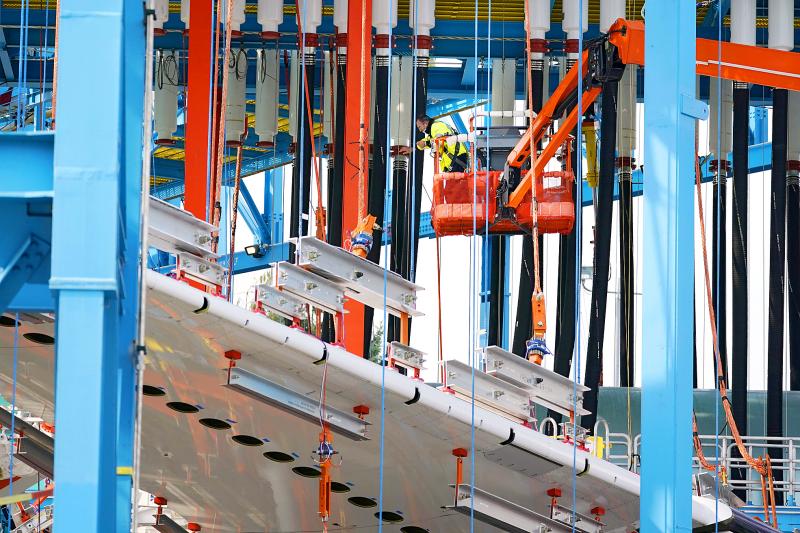Boeing Co on Thursday said it is uprooting the 787 Dreamliner program from a manufacturing hub north of Seattle and shifting the work to a non-union plant in South Carolina amid slumping sales of wide-body jetliners.
Production of the marquee twin-aisle jetliner will be consolidated in North Charleston in the middle of next year by the company’s best estimate, Boeing said in a statement.
The planemaker did not disclose how many jobs it intended to cut, saying it is still assessing the potential impact on its factory complex in Everett, Washington, where it employs about 30,000 people.

Photo: AP
The move bolsters Boeing’s decade-long expansion in South Carolina, which hosts the company’s only final jetliner assembly line outside its century-old base in Washington State.
As the company braces for years of weak orders, the consolidation also raises doubts about the future of Boeing’s mammoth wide-body factory in Everett, a plant that was carved out of marsh and forest in the 1960s to house production of the 747 jumbo jet.
“It became clear that consolidating to a single 787 production location in South Carolina will make us more competitive and efficient, better positioning Boeing to weather these challenging times and win new business,” Boeing commercial airplane division head Stan Deal said in a message to employees.
In making the decision, Boeing weighed logistics, efficiency and the “long-term health of our production system,” among other considerations, Deal said.
The COVID-19 pandemic has devastated the company’s sales outlook by sapping demand for flights, especially on the international routes plied by wide-body jets, such as the Dreamliner.
Boeing rose 1.6 percent to US$167.86 at the close of trading in New York on Thursday.
The shares have tumbled 48 percent this year, the biggest decline on the Dow Jones Industrial Average.
Boeing’s 787-only factory in North Charleston has been controversial since inception more than a decade ago, when senior leaders at the firm, including then-chief executive officer Jim McNerney, were chafing at a lengthy machinists’ union strike that hobbled manufacturing near Seattle.
Quality issues at the plant drew the attention of US regulators and came to the fore again in recent weeks as Boeing was forced to ground eight Dreamliners because of potentially dangerous structural weakness.
About 1,000 mechanics and electricians assemble Dreamliners in Everett. Boeing also employs manufacturing and industrial engineers who provide daily support on the factory floor, and design engineers who configure airplanes to customer specifications.
It is not clear how many engineers might lose their jobs.
Many of them support multiple airplane programs and Boeing’s Work Life computer system has been bedeviled by glitches as the company carries out large-scale layoffs, said the Society of Professional Engineering Employees in Aerospace (SPEEA), an engineering union with 17,600 members.
“We believe Boeing is making a mistake,” SPEEA executive director Ray Goforth said.
Jon Holden, president of machinists’ union that represents touch labor at the factory, called the move “just another in a string of bad decisions Boeing has made that fails to capitalize on the strengths of our workforce.”
Boeing said it would keep building 787s in Washington until it lowers output to a six-airplane monthly rate next year.
However, by spreading Everett’s costs over a smaller production base by the middle of next year, the company risks creating a financial drag that lowers the profits of the remaining wide-body programs and its mainstay commercial business.

The US dollar was trading at NT$29.7 at 10am today on the Taipei Foreign Exchange, as the New Taiwan dollar gained NT$1.364 from the previous close last week. The NT dollar continued to rise today, after surging 3.07 percent on Friday. After opening at NT$30.91, the NT dollar gained more than NT$1 in just 15 minutes, briefly passing the NT$30 mark. Before the US Department of the Treasury's semi-annual currency report came out, expectations that the NT dollar would keep rising were already building. The NT dollar on Friday closed at NT$31.064, up by NT$0.953 — a 3.07 percent single-day gain. Today,

‘SHORT TERM’: The local currency would likely remain strong in the near term, driven by anticipated US trade pressure, capital inflows and expectations of a US Fed rate cut The US dollar is expected to fall below NT$30 in the near term, as traders anticipate increased pressure from Washington for Taiwan to allow the New Taiwan dollar to appreciate, Cathay United Bank (國泰世華銀行) chief economist Lin Chi-chao (林啟超) said. Following a sharp drop in the greenback against the NT dollar on Friday, Lin told the Central News Agency that the local currency is likely to remain strong in the short term, driven in part by market psychology surrounding anticipated US policy pressure. On Friday, the US dollar fell NT$0.953, or 3.07 percent, closing at NT$31.064 — its lowest level since Jan.

Hong Kong authorities ramped up sales of the local dollar as the greenback’s slide threatened the foreign-exchange peg. The Hong Kong Monetary Authority (HKMA) sold a record HK$60.5 billion (US$7.8 billion) of the city’s currency, according to an alert sent on its Bloomberg page yesterday in Asia, after it tested the upper end of its trading band. That added to the HK$56.1 billion of sales versus the greenback since Friday. The rapid intervention signals efforts from the city’s authorities to limit the local currency’s moves within its HK$7.75 to HK$7.85 per US dollar trading band. Heavy sales of the local dollar by

The Financial Supervisory Commission (FSC) yesterday met with some of the nation’s largest insurance companies as a skyrocketing New Taiwan dollar piles pressure on their hundreds of billions of dollars in US bond investments. The commission has asked some life insurance firms, among the biggest Asian holders of US debt, to discuss how the rapidly strengthening NT dollar has impacted their operations, people familiar with the matter said. The meeting took place as the NT dollar jumped as much as 5 percent yesterday, its biggest intraday gain in more than three decades. The local currency surged as exporters rushed to